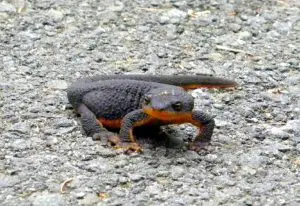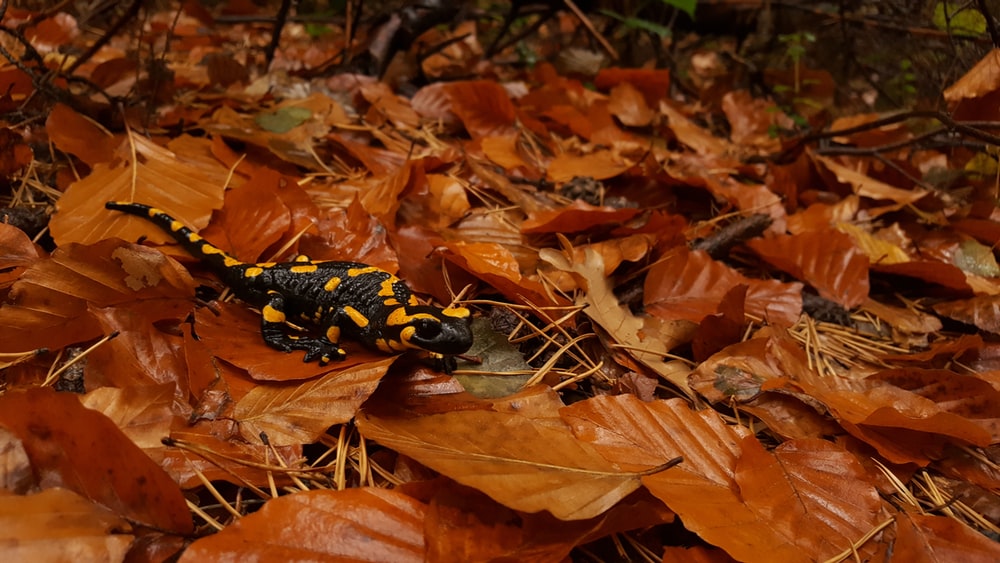I have been lucky enough to see salamanders in the wild, both times were when I was digging a pond in the backyard. They are such mystical and beautiful creatures.
You could almost say they look like a cross between some kind of prehistoric species and a miniature dragon!
Read here about Axolotl care. Make sure you give them the right food.
You may have seen the odd one in the wild too or you may even own some as pets. Whatever the story, you have found yourself on this article about poisonous salamanders. So, are salamanders poisonous?
So I am going to give you a little briefing about the contents of this article. You are going to learn everything you could ever want to know about if salamanders are poisonous and if you can handle them. There will be a lot of other cool information as well so make sure to read it all.
Are salamanders poisonous?
Ok let’s jump straight into the main question after all it is what you care here to read about. Stick around though as I am going to tell you loads more vital information that will keep both you and the salamander healthy!
Are salamanders poisonous? The quick answer to this is unfortunately yes. Salamanders are poisonous and the way that they administer the poison is through secretion glands within its skin. The danger of the poison is dependent upon the species of salamander.
There you go, salamanders are poisonous. However there is so much more to cover so read on.
Are salamanders venomous?
No salamanders are not venomous, they are poisonous.
This is a question that confuses some people when they find out that a salamander is poisonous. They instantly associate that with being venomous.
This is not the case though as to be venomous the poison needs to be injected into the flesh via fangs, spines or stingers. Creatures that do this include snakes, spiders scorpions and the like.
As mentioned earlier a salamanders poison is excreted through its skin and is not injected so a salamander is not venomous.
Are salamanders dangerous to humans?
The simple and to this is no. Salamanders are not dangerous to humans. In most instances you will not even come across a salamander, they are really quite hard to find.
By nature a salamander is very docile and does not attack. They do not particularly bite and they do not actively go out to try to stack or injure humans.
The only way that a salamander can hurt or injure a human is through its toxins that are secreted through its skin. It does this naturally as a defence mechanism. So unless you are handling salamanders and the ingesting the poison, there should be no dangers at all.
What is the most poisonous salamander?
The title of the most poisonous salamander goes to the Rough Skinned Newt. It can be found in areas of the west coast of the US and has a very toxic coating of neurotoxin called tetrodotoxin.
This stuff is very nasty and can be deadly if ingested! There have also been noted cases of skin irritation through dermal contact.
The bottom line is that you do not try to handle one of these salamander if you happen to find one.
Below is a photo of a rough skinned newt so that you know what to look out for next time that you are out hiking!

Are salamanders poisonous? Rough Skinned Newts are the most poisonous species of salamander.
Can you hold a salamander?
In theory yes you can hold a salamander. As long as you wash your hands straight away and do not put your hands near your eyes or mouth.
However you should not hold a salamander. In general salamander will not be happy about being held. It will cause it untold stress and that is not good.
Salamanders are better off being watched from a distance in their natural environment and left without disturbance.
If you own a pet salamander you should try to handle it as little as possible. This will keep both you and the salamander safe, and also your pet happy.
You can hurt a salamander by handling it!
Did you know that a salamanders skin is very absorbing. Yes it secretes deadly toxins, but it also absorbs chemicals as well and this can be dangerous for salamanders.
When you handle a salamander it can actually soak up the oils from your skin or anything else that you have on your hands. This can be deadly for the Salamander and is another reason why they should not be handled unless necessary.
Are all salamanders poisonous?
Are salamanders poisonous or just some? From the research I have made it does seem that all salamander species have toxins of some sort. These toxins are of varying strengths and doses though dependant on which salamander we are talking about.
Because of this it is highly recommended that you do not attempt to handle a salamander unless you are trained. It is not worth the risk.
Do salamanders make good pets?
For me personally I like to see salamanders in their natural environment. However I can totally understand why someone would want to keep them as a pet, after all they are beautiful and majestic creatures.
I do believe that it is quite a commitment to keep them as pets and should only be undertaken by someone who knows what they are doing.
It is not recommended to buy a salamander as a pet if you are looking for a pet that you can handle. They are much better suited to not being handled and instead observed from a distance.
Conclusion.
Are salamanders poisonous? The salamander is an awesome little creature that is best to be observed from a distance. It secretes powerful toxins which it uses as a defence to stop predators from trying to eat it.
If you are lucky enough to see one in the wild observe it but please do not try to handle it.
If you would like to own one as a pet be aware that they are delicate and do not like to be handled. You really do not want to get their toxins on you and it is not safe for the salamander to soak up your oils.
